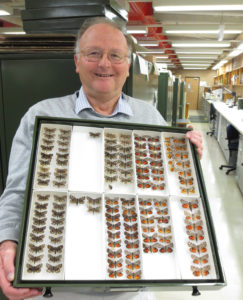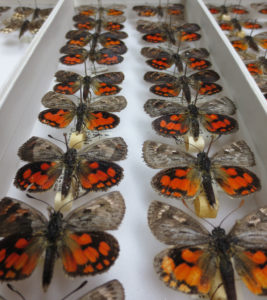Moths and butterflies have enchanted naturalists for centuries. Beloved among insects, the Lepidoptera - as they are known in scientific circles - have been collected, curated and classified in their millions.
The Australian National Insect Collection (ANIC) is the world’s largest collection of Australian insects. It’s home to 12 million specimens, including 2.3 million moths and butterflies. Flitting among the steel cabinets where moths and butterflies are pinned in drawers is Ted Edwards, who was 2015’s recipient of the Karl Jordan Medal for outstanding original research on moths and butterflies internationally.

Ted and his colleague Marianne Horak are Honorary Fellows at ANIC, where they curate the collection of moths and butterflies, mentor amateur naturalists and quietly make great contributions to our understanding of Australian Lepidoptera. Both Ted and Marianne have long eschewed the temptations of retirement in the firm belief that no hobby, no destination could be as interesting or as important as continuing their life’s work.
Australia is blessed with an incredible evolutionary heritage. Our geological history has granted us the dual blessings of time and isolation: time for evolutionary processes to create diversity in isolation from species elsewhere. Today more than three quarters of our plants and animals are endemic, occurring nowhere else in the world. Perhaps nowhere is our abundance of diversity and deep evolutionary history more evident than among the Lepidoptera.
Uncle Ted, as he is known to the army of volunteer Lepidopterists who assist him, has worked on moths and butterflies for nearly half a century. He wrote much of their phonebook, Checklist of the Lepidoptera of Australia, an incredible listing of more than 11,000 species.
When asked for a highlight from a life in science, receiving poo in the post is at the top of Ted’s list of interesting days. It’s not everyone’s idyll but poo, in this case of a tree kangaroo, is better thought of as a nutritious package of condensed leaves, a cradle for a caterpillar. From this particular poo, posted by a friend in the Atherton Tablelands, Ted raised an oecophorid moth and delighted in its slow passage from caterpillar to adult. Destined to captivate future generations of Lepidopterists, this moth will spend its afterlife in the insect collection alongside specimens representing 16,000 species of Australian moths and butterflies, each with their own story to tell about our biodiversity.
Like gazing at the stars and feeling the wonder of the universe, naturalists like Ted and Marianne intuitively understand the value of Lepidoptera. We are surrounded by a universe of moths and butterflies and yet we have paid them so little attention we barely know what exists. Ted’s phonebook of Lepidoptera is a magnificent achievement but a work in progress. Many species are still unlisted, not described by science.

With more than 20,000 species of moths and butterflies living among us, the industrial minded will immediately realise that Australia’s evolutionary heritage represents a huge unmined resource. Silk production is a moth-based industry dating from ancient times. Butterflies pollinate our macadamia trees and many native plants are dependent on moth pollinators.
To evolutionary biologists, our moths and butterflies help reveal the story of the tree of life. Our remnant Lepidoptera from Gondwana have helped unravel the relationships between moths and butterflies overseas, because some groups have survived in Australia but not elsewhere and these can link groups known overseas.
For many people around the world, butterflies have huge cultural meaning, a widespread presence in popular culture and a symbolic meaning in art. In post-reformation Holland, with images of Saints not appropriate any longer, the so-called Vanitas images referring to the brevity and meaninglessness of earthly life, frequently used caterpillars and butterflies as symbols of resurrection.
From a more practical perspective, Australia’s most economically damaging insect is a moth—Helicoverpa armigera (known as cotton bollworm, or corn earworm). And certain butterflies are pests of horticulture. It’s important to prevent similar pests from crossing our borders from overseas, yet biosecurity efforts to prevent a particular species from taking up residence are wasted if it’s already here. We need that species phonebook to be comprehensive.
For all our sakes, conserving the diversity of living things and maintaining natural habitats is important in and of itself. Collections of moths and butterflies are fundamental for understanding this order of insects and driving discovery.
ANIC is the world’s largest collection of Australian insects, with over 12 million specimens. Find out more about their moths and butterflies[Link will open in a new window].
More information
- Meet the Enigma moth[Link will open in a new window]
- Australia's iconic scribbly gum moths[Link will open in a new window]
